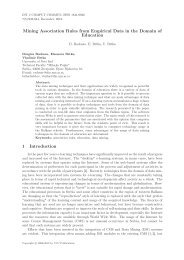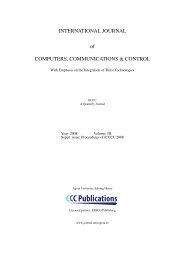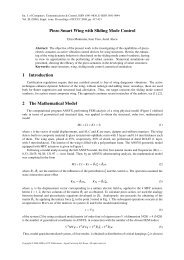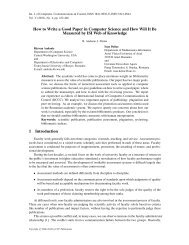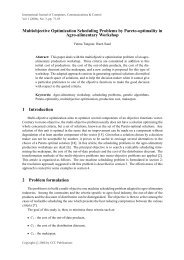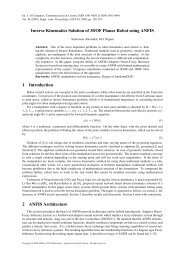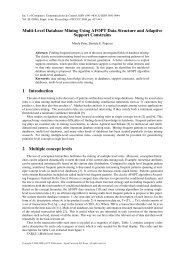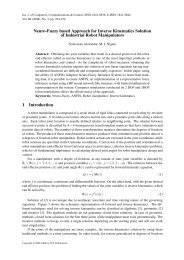A Microcontroller-based Intelligent System for Real-time Flood ...
A Microcontroller-based Intelligent System for Real-time Flood ...
A Microcontroller-based Intelligent System for Real-time Flood ...
Create successful ePaper yourself
Turn your PDF publications into a flip-book with our unique Google optimized e-Paper software.
A <strong>Microcontroller</strong>-<strong>based</strong> <strong>Intelligent</strong> <strong>System</strong> <strong>for</strong> <strong>Real</strong>-<strong>time</strong> <strong>Flood</strong> Alerting 847<br />
5. IF flood_risk = yes THEN<br />
(a) hydrologic alert code transmission.<br />
The parameters measurement step requires periodic measurements of specific parameters<br />
such as water flow, water level, river flow rate, temperatures. The equipment used <strong>for</strong> per<strong>for</strong>mance<br />
measurements and processing of hydrological parameters of the water courses are the<br />
gauging stations. The instrumentation used <strong>for</strong> parameters measuring vary from groom gauging,<br />
pluviometric devices to measure the rainfall, river ratchets gauging <strong>for</strong> speed measurements, to<br />
automatic instrumentation that can measure most of the hydrological parameters that are monitored.<br />
The parameters processing step involves the <strong>for</strong>m factor computing <strong>for</strong> each sub-catchment<br />
coefficient of flood <strong>for</strong>m, and the determination of the coefficient of leakage in the warning subbasins.<br />
The parameters transmission step is realized through a communication channel, such as<br />
internet, radio or mobile phone. The parameters analysis step is the most important step because<br />
the subsequent correct decisions are taken in case of flood waves. It consists in the following<br />
three steps:<br />
1.<br />
• determination of the average level of precipitations;<br />
• calculation of the maximum flow in each sub-basin of the downstream warning sub-basins;<br />
• <strong>based</strong> on the calculations made in the previous two steps, the system analyses the risk of<br />
flood production by using the rules from the knowledge base that is incorporated in the<br />
intelligent system; the rules are given the hydrological alert code (yellow, orange and red).<br />
As an example, the main characteristics of the knowledge <strong>based</strong> system are presented in Table<br />
Table 1: The rules of the knowledge base (selection)<br />
RULE 1 IF flow < attention AND precipitations < 40l/m 2 THEN hydrologic_code = green;<br />
RULE 2 IF flow ≥ attention AND flow < alert AND precipitations < 40l/m 2 THEN<br />
flood_risk = YES AND hydrologic_code = yellow;<br />
RULE 3 IF flow ≥ attention AND flow < alert AND precipitations > 40l/m 2 THEN<br />
flood_risk = YES AND hydrologic_code = orange;<br />
RULE 4 IF flow ≥ alert AND flow < danger AND precipitations < 40l/m 2 THEN flood_risk<br />
= YES AND hydrologic_code = orange;<br />
RULE 5 IF flow ≥ alert AND flow < danger AND precipitations > 40l/m 2 THEN flood_risk<br />
= YES AND hydrologic_code = red;<br />
RULE 6 IF flow ≥ danger THEN flood_risk = YES AND hydrologic_code = red;<br />
The precipitations are occurring predominantly as rain or snow. The fall of rain is the largest<br />
factor contributing to increased river flows. Snow versus rain is the second source of precipitation.<br />
Melting snow during spring has a considerable impact on river basin management. Tracking the<br />
level and the periodicity of precipitation involves measuring them by using existing sensors<br />
and transducers gauging stations. Warning about the risk of flood is used to take appropriate<br />
decisions from the analysis of all in<strong>for</strong>mation related to the maximum river flow. If the analysis<br />
step indicates a possible flood production then the prevention system will send signals to the<br />
members of the Emergency Situations Committee. The hydrological alert (containing the alarm<br />
severity code of flooding) can be transmitted online to PDAs, smart terminals with a GPS and



